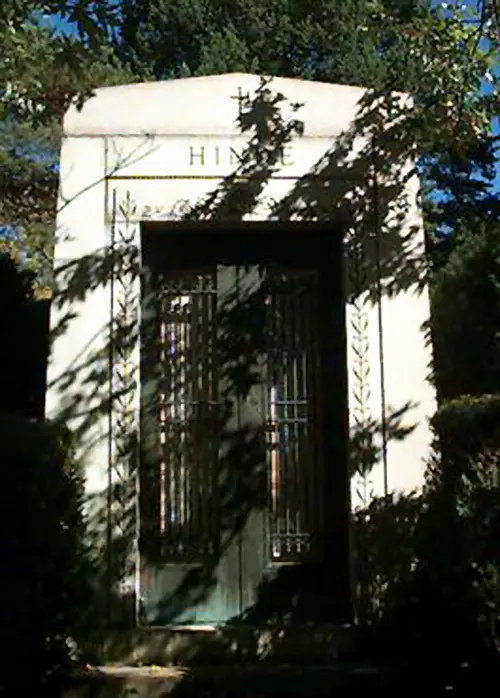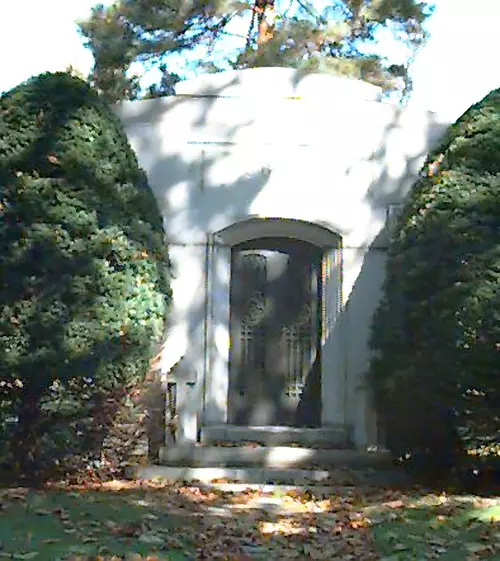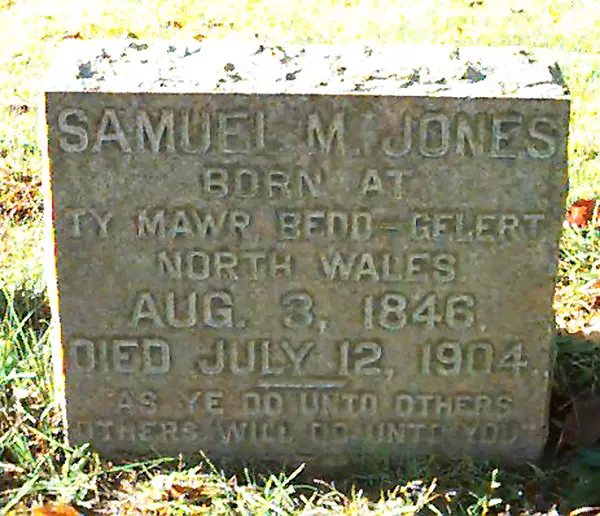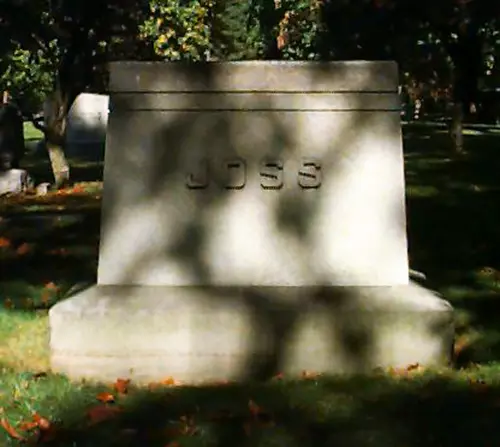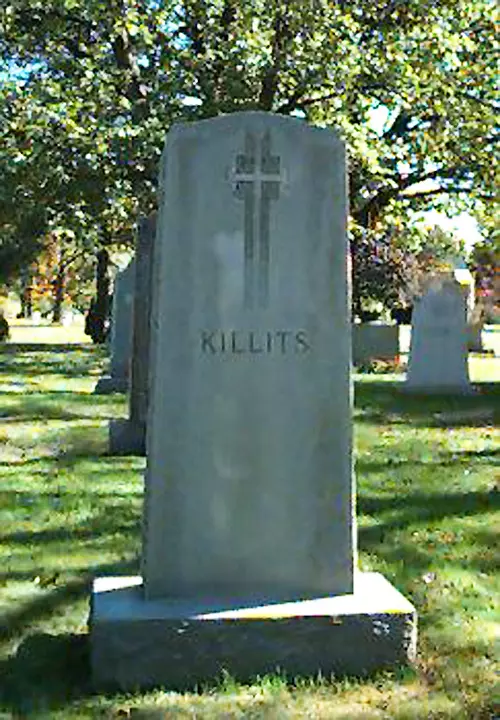John C. Gipe - Benjamin F. Griffin - John Gunckel - Arthur Hickock - Henry Hinde - Hugh Webb Hubbard - Thomas Hubbard - Samuel Milton Jones - Adrian "Addie" Joss - John Milton Killits
John C. Gipe
Born in Indianapolis on May 12, 1881, John C. Gipe attended Indiana public schools and graduated from Indiana University. He found his first job with a Plate Glass firm in Alexandria, Indiana. In 1910, he left that company to take a superintendent position at Kitanning Plate Glass Company in Pennsylvania. For the next fourteen years, Gipe received steady promotions while working for the Standard Plate Glass Company in Butler, Pennsylvania, Valley Park, Montana, and Homestead, Pennsylvania. In Homestead he joined the U.S. Steel Company and finally the American Plate Glass Company in Kane, Pennsylvania.
In 1924, John Gipe left his position in Kane and went to Toledo as manager of the East Toledo plant of the Libbey-Owens Sheet Glass Company. Within six years, Gipe advanced to managing the entire plate glass division of the company's several plants. This promotion came in conjunction with the company's consolidation with the Edward Ford Plate Glass Company in July of 1930. While in Toledo, Mr. Gipe was involved with the Toledo Club, Toledo Country Club, the Masonic Order and the Collingwood Presbyterian church.
John Gipe retired from Libbey-Owens-Ford in 1940 when he was stricken with a heart ailment. While visiting his daughter in Baltimore for Thanksgiving, Gipe suffered a heart attack. He and his wife, Mary, decided to remain in Baltimore for his recuperation. His condition improved steadily and he and Mary began to make plans to return to Toledo. Those plans were interrupted, however, when Gipe suffered a second, fatal heart attack. John Gipe died on February 9, 1941 and was returned to Toledo to be buried at Woodlawn Cemetery. [Toledo Biographical Sketchbooks (GERS-GODW) Local History Room, Toledo Lucas County Public Library]. (Toledo Blade, February 10, 1941), (Toledo Times February 10, 1941.)
Benjamin F. Griffin
Benjamin F. Griffin was involved in the creation of the Woodlawn Cemetery Association. He was also one of the first trustees of the Woodlawn Cemetery Association. In December of 1876, he was one of the last remaining members of the first trusteeship. The people who made up the first board of trustees were St. John, Phillips, the Walbridges, Strattor, Steffers, Curtis, and Malone. Griffin died on January 28, 1900.[Clark Waggoner, ed., History of Toledo and Lucas County. (New York: Monsek & Company Publishing, 1888), p.563].
John Gunckel
John Gunckel was the founder and life president of the Toledo Newsboys Association. The Newsboys Association was dedicated to taking care of the boys of the streets and making certain that they grew up to be responsible adults. Gunckel believed there was good in every boy and girl.[John E. Gunckel, in The Story of the Maumee Valley, Toledo and the Sandusky Region, Charles S. Van Tassel, ed. (Chicago: The S.J. Clarke Publishing Co., 1929), 269-270.]
John Elstner Gunckel was born in Germantown, Ohio, on August 14, 1846. After attending Oberlin College for three years he moved to Toledo in 1875. Though starting out in real estate he eventually became employed as a ticket agent for the Lakeshore and Michigan Southern Railroad. He was promoted to a traveling passenger agent and ended up representing the railroad for twenty years.
It was during this time that John Gunckel began taking newsboys and the other boys of the street out to dinner. Soon Gunckel was holding Sunday afternoon entertainment for the boys. Finally, in 1891 he gathered over 100 newsboys together for a Christmas dinner. Following the dinner, John Gunckel formed the Toledo Newsboys Association. Once, when speaking about his program, he said, "There are in all of us hereditary tendencies to both vice and virtue, and under favorable surroundings these tendencies will either be dormant or developed".[Trustees of Toledo Newsboys Association, In Memory of John E. Gunckel: Founder and Life President of the National and Toledo Newsboys Association. (Toledo: Trustees of Toledo Newsboys Association, 1915), pp.49-50]. Gunckel taught the boys to play square, live clean, be honest and respect others.(Van Tassel, p.270). As Newsboys they were forbidden to smoke or swear.(Trustees p.34). The Newsboys often would bring to John Gunckel all the lost items they found on the street.(Ibid., p.49).
In 1904, at the St. Louis Worlds Fair, John Gunckel announced the formation of the National Newsboys Association. He was president for life of both the Toledo and the national organizations.(Ibid., p.8). The Newsboys Association also included the Newsboys Cadets, the Newsboys Sisters Auxiliary, and the Newsboys Band.(Van Tassel, p.272).
For all his charitable work John Gunckel was much beloved. He once declined an offer from the Lake Shore railroad to pay his salary while he worked full time with the boys. He turned down offers to run for mayor because he was so devoted to his work. John Gunckel was an honorary member of every club in Toledo.(Trustees, p.8). In 1909 the Newsboys building was built on Superior Street with contributions from Newsboys' and businesses.(Van Tassel, p.270).
John Gunckel spoke and wrote about the Newsboys nationwide. He gave talks to state teachers associations and even appeared on the platforms with politicians, such as William Jennings Bryan.(Trustees, p.13). John Gunckel told the story of the Toledo Newsboys association in his book Boyville.(Van Tassel, p.274).
John Gunckel died on August 16, 1915, and thousands of citizens in Toledo mourned. On the day of his services many people waited outside the Newsboys Building to be admitted. After the funeral service, the Newsboys Band led the procession to Woodlawn Cemetery. People watched the procession from the streets and from inside the cemetery. John Gunckel was put in his vault and many people walked on a ground covered with flowers. The children gave small bouquets, while white rosebuds formed the name Gunck.(Trustees, p.13).
Later the Newsboys would honor John Gunckel by donating and collecting money to build a monument to him at Woodlawn. It is a pyramid made of stones donated by the children. The epitaph reads:
Who saw in every boy a man
Of worth and purpose like Gods plan
and said to him: Do right-You can!The Boys Club of America. (A pamphlet concerning the Toledo Newsboys Association. The Boys Club of America).
It is a tribute to John Gunckel that even after almost fifteen years the city of Toledo was still giving recognition to his contributions. John Gunckel had brought the first Lotus flower to Toledo from the Nile Valley. On August 14, 1929, John Gunckels birthday, was proclaimed to be Lotus flower day by Mayor William T. Jackson. People were encouraged to go to Gunckels monument at Woodlawn for a ceremony to mark the day.(Van Tassel p.272). For many years over 1000 people would turn out at Woodlawn on the anniversary of his death.(John Gunckel Memorial Crumbling, Toledo Blade 4 October 1979). The city of Toledo loved and respected John Gunckel.
Arthur Hickock
Arthur Hickock was a pioneer in the oil industry at the time of the automobile boom. He eventually became one of Toledo's wealthiest citizens, the president and treasurer of the Hickock Oil Company. He was born at Thompson Ledge, Ohio around the year 1874. His first business venture was a general store in Geneva. He then bought his Toledo department store in the early 1900's during a two-hour train stopover. The Hickock Daylight Store was located on Summit Street. However, Hickock's career was about to take a turn into the gasoline business.
With his store doing well, Hickock made an investment in a filling station at Detroit and Glenwood. A farmer then asked him for a loan to drill for oil on his property. Hickock agreed, but the first spot they picked was dry. Hickock by chance suggested another spot where oil was struck. Hickock then founded the Hickock Producing Company. The Daylight Store burned down in January 1915 after which Hickock concentrated his attention fully on the petroleum industry.
In the stove oil business his biggest customer was the Standard Oil Company. Son Hickock, in conjunction with a Detroit Stove dealer, was selling it straight to the consumer. With automobiles beginning to gain in popularity, he moved into the motor fuel business in 1917. Hickock had his original filling station and also the Jefferson garage. He was successful between 1917 and 1928 and the company expanded to 280 stations. His business began to expand dramatically. Between 1928 and 1935, he gained control of the marketing organizations of such companies as the Wilson & Highland Co. of Detroit and the Pocahontas Oil Co. of Cleveland. The number of his filling stations reached 1,800. Hickock's brand of gasoline was called "Hi-Speed."
All was not well, though, during these years with the nation in the Depression Hickock worked hard to hold on to his business. Hickock's office help worked two shifts and Hickock worked both . His days could run 18-20 hours. When he died in 1945, his company was worth fifteen million dollars, and he left a personal estate of five million dollars.
Upon his death, his will stated that large amounts of the estate were to go to his employees and to various charitable institutions. This generous provision was immediately challenged by the executors of the will: Captain Clarence Hickock, his son; the Toledo Trust Company; and Walter G. Kirkbride, the new president of the company. They argued that since the will was less than one year old and there were living descendants, that under Ohio law, the will was invalid.
In 1948 his employees received $40,000. The charities and the estate remained embroiled in a lengthy legal battle until 1961. It was decided that the original grounds under which the will had been challenged were legitimate in Ohio but some of the Hickock holdings were in other states and could not be bound by Ohio law. The charities finally received some of the estate.[Toledo Biographical Scrapbook (Hick-hire) Local History Room, Toledo Lucas County Public Library.]
Henry Hinde
Henry Hinde was born in Norwalk, Ohio on March 17, 1863. In 1886 when he came to Toledo, his first job was with the Union Manufacturing Co. This job did not last long, however, and Hinde started work at the Jewel Sewing Machine Company. In 1887 he left Toledo to take a job in Pittsburgh.("Hinde Built Tool Company into One of Major U.S. Firms," Toledo Blade 17 December 1947). Hinde returned to Toledo in 1890 and in March purchased an interest in the Toledo Machine and Tool Works. The total worth of the company was $30,000. The number of people employed was 20. In November, Toledo Machine and Tool Works was incorporated. At that time, Hinde was named the company's president and general manager.("Henry Hinde, Retired Manufacturer, Dies," Toledo Times 17 December 1947). Seven years later Hinde and his brother, Louis, bought the company. The company acquired property at Hastings and Dorr Streets that he called Plant No. 1.
In 1918, Hinde built a new plant at Westwood Avenue and Dorr Street. Two years later the firm completed a foundry there. It was capable of 1200 tons of castings a month. Eventually, the foundry was able to produce 2,200 tons. By that time the once small company employed over 1600. The company became one of the leading designers and builders of power presses and dinkred machines and tools in the United States.("Hinde Built") Though he stayed with the firm, the controlling interest was purchased by a brokerage house in 1922 for $4,000,000."Henry Hinde" Ten years later the firm was absorbed by the E.W. Bliss Co. and Hinde decided to retire from it.
Hinde began to enjoy the life of leisure he had made for himself. He spent winters in Florida and spent time playing bridge. He was also an excellent golfer. In 1933, in Palm Beach, Florida, he won the Governor's Cup and Davies Medal at the Golf Championship of the Old Guard Society. He was also a member of the Toledo Chamber of Commerce, The Toledo Club, Inverness Country Club, Knights of Columbus, and Rosary Cathedral Parish."Hinde Built" His wife Jenny died in August 1943, and four years laters, on December 16, 1943, Henry Hinde joined her.("Henry Hinde")
Hugh Webb Hubbard
Hugh Webb Hubbard was born on September 27, 1889 to Wit and Mary Hubbard. Wit Hubbard was the president of the Wit Hubbard Lumber Company. The firm had been founded by Hughs grandfather in the 1850's.
Hugh was raised in Toledo and attended St. John's High School and College. During this time Hugh served as a member of the Ohio National Guard. In 1916, Hubbard was stationed on the Mexican border. The next year he served in D-Troop, First Ohio Cavalry. During WWI he was a member of the machine gun battalion of the 37th Division at Champ Sheridan, Montgomery, Alabama. Whilst in the army Hubbard proved to be an expert marksman who won many sharpshooting awards and medals.
After the war he attended St. John's College. He eventually left college and joined the family company. In 1921 his father died and H.W. Hubbard became president and treasurer.("H.W. Hubbard, Lumber Firm President, Dies," NewsBee 9 April 1929). He was a member of the American Legion, the Issac Walton League, and the Fraternal Order of Eagles. He was also an experienced game hunter.
When he died of pneumonia on April 8, 1929, H.W. Hubbard left a wife, Mary, and two young sons.("H.W. Hubbard is Pneumonia Victim," Toledo Times 9 April 1929). Hubbard had hoped to one day see his son, William, president of the family company. However, William was only eight at the time of his father's death, and three generations of family control ended.("H.W. Hubbard, Lumber Firm President, Dies.")
Thomas Hubbard
Thomas Hubbard was born in Ashtabula, Ohio, on July 11, 1859.[Toledo Biographical Scrapbook. (Hols-Hubb) Local History Room. Toledo Lucas County Public Library]. Thomas Hubbard entered the Western Reserve University Preparatory School in 1879. In 1880 he became a student at the University of Michigan.[Killits, John. Toledo and Lucas County, Ohio: 1623-1923. 3 Vols. (Chicago: S.J. Clarke Publishing Co., 1923). p.660]. He graduated in 1882 with a Ph.D and, inspired by the example of his uncle, Dr. John C. Hubbard, attended medical school at Western Reserve Medical College from 1882 to 1883.(Toledo Biographical Scrapbook)
In 1883 he continued his studies at the medical department of the University of Pennsylvania. Two years later he graduated with a medical degree. Hubbard then opened a practice in Ashtabula. In 1887 he was given the opportunity to study for six months at the University of Vienna, Austria. When he returned in 1888, he set up an ear, nose and throat practice in Toledo.
Hubbard was a pioneer using new medical discoveries soon after their discovery. This included intubation for membranous croup and the first use of the diphtheria antitoxin in Toledo. After he left private practice he worked at several different hospitals. During his life he worked at the Toledo Hospital, St. Vincent's Hospital, Robinwood Hospital and Flower Hospital. Hubbard was a member of the American and Ohio State Medical Associations and served as President of the American Laryngological Association in 1913.(Killits, pp. 660-61).
He married Charissa Braves on September 4, 1889. He was also involved with the Adams Street Mission and a member of the Trinity Church.
Samuel M. Jones
Samuel Milton Jones, often referred to as "Golden Rule" Jones, was born August 3, 1846 in North Wales. He and his family emigrated to Lewis County, New York, when he was three years old. He grew up in New York State until he moved to Titusville, Pennsylvania. When he was eighteen years old he worked in the oil fields of Pennsylvania. Here he studied different methods of oil production and became a producer himself in 1870.[John Killits. Toledo and Lucas County, Ohio, 1623-1933, vol. 1 (Toledo: S.J. Clarke Publishing Company, 1923), p.307].
Depressed by the death of his first wife, he moved to Ohio seeking a change. In 1886, with his headquarters in Lima, Ohio, he operated oil fields. He made a big strike near Lima in 1886. That same year he met Helen W. Beach, a lady from a prominent Toledo family. In 1892 they married and settled in Toledo.[Morgan Barclay and Charles Glaab. Toledo: A Gateway to the Great Lakes (Tulsa: Continental Heritage Press, 1982), p.84].
In 1893 Jones invented the "sucker rod." This permitted deep-well drilling. He patented his invention and began to manufacture it. In 1894 he began Acme Sucker Rod Company. His factory was open during a time of depression and Toledoans sought work there. In his company he enforced the Golden Rule. He treated his employees well and paid them a fair wage. He also had workers keep their own time, gave employees paid vacations, had company insurance plans, and allowed employees to be active in profit sharing.(Ibid., pp.84-85).
Jones was elected mayor of Toledo on February 25, 1897, after having lived in Toledo for only five years. He was a progressive mayor who preached Christ's teachings, supported the idea of equality of men, and focused on establishing a uniform three-cent fare on streetcars, as well as solving problems of unemployment and poverty.(Ibid., p. 85). A campaign promise was to establish public parks and playgrounds. He believed this was important and, as an example, he purchased vacant ground that adjoined his factory and equipped it with everything necessary for a playground. This area, named Golden Rule Park, was created three years after he was elected mayor.(Killits, Toledo and Lucas County, Ohio, vol. 1, p.307).
Jones was elected again in 1899, 1901, and 1903. He died before his fourth term expired on July 12, 1904, at the age of fifty-seven. Fifty-five thousand people viewed his body and five thousand people from all walks of life attended his funeral. He was survived by his three sons, Percy, Paul and Mason, and his wife Helen.(Ibid). He rests in lot 14, section 39.
Percy C. Jones was born in Turkey City, Pennsylvania, February 6, 1878. He came to Toledo with his father in 1892. He was president of the S.M. Jones Co. and the Toledo Zoological Society. He died October 9, 1941 in Beaumont, Texas. His wife, the former Marion Cullen, was born in Boston and was a well-known actress before her marriage to Percy Jones in 1902. She died March 12, 1965.(The Blade, 10 October 1941).
Paul Jones, born in Duke Centre, Pennsylvania came to Toledo with his father when he was about ten. He was president of Malleable Casting Company and the S. M. Jones Company. He died on April 14, 1951, four years after he retired as president of the S.M. Jones Company.(Ibid., 14 April 1951).
Mason B. Jones joined his father's oil well equipment firm in 1935. He was president of the S.M. Jones Company until he retired in 1963. While the other two sons were from Samuel Jones's first wife, Mason's mother was Helen Beach Jones. He was a lifelong Toledo resident, attended Scott High School, and was active in the Toledo Boy's Club. He passed away in 1968.(Ibid)., 1968.
Helen Beach Jones, Samuel M. Jones's second wife, was born in Toledo on April 28, 1857. She was his helpmate during the years he made national history as the mayor of Toledo. She composed music, gave lessons, and was active in the Toledo Women's club, the Samagama Club, and laid the groundwork for Beach house, a homeless women's shelter named for her mother. She died October 6, 1940 at the age of 83.(The Toledo Times, 6 October 1940).
Adrian "Addie" Joss
Adrian "Addie" Joss was born April 12, 1880, in Wisconsin. When he was a teenager, he made a name for himself while pitching for amateur teams around his home state. He was an excellent student who studied journalism and played ball at the University of Wisconsin. In early 1900 a traveling salesman recommended Addie as pitcher to the manager of the Toledo Mud Hens, Bob Gilk, who signed the 19 year old to his first professional contract.(David Lee Fleitz, "One of Toledo's Winners. Toledo Biography Scrapbook).
In Toledo, Addie won nineteen games in 1900 and twenty five in 1901. Since he did not have a binding contract with the team, the Cleveland Club of the new American League paid the Mud Hens $500 for him. This was the beginning of a major-league career for Joss. The first game he pitched for Cleveland was on April 26, 1902 when he defeated the St. Louis Browns.(Ibid).
Playing for the Cleveland Naps (now called the Indians) from 1902 to 1910 gave Joss the reputation as being a premier pitcher in the American League's first decade. He won twenty plus games four seasons in a row, having 160 victories in his career. This included a perfect game, two no hitters, and three one hitters. He was only the fourth pitcher in major league baseball history to throw a perfect game.Ibid. Moreover, the 6'3" player had a great fastball that earned a run average of 1.88, pitching 45 shutouts and 2 no hitters and compiling a lifetime record of 160-97.(Toledo Blade, 1 February 1978.)
Addie finished 650 of his first 61 major league starts, walked only 370 batters in more than 2,200 innings, and was the finest fielding pitcher of his time. Ty Cobb, the Detroit star who is well known for his great batting record, faced Addie 73 times and managed only 17 safe hits. From 1905 to 1908, Addie helped win 92 games and the Naps (named for the Manager, Napoleon Lajoie) began to climb to the top of the American League standing. The best season for this right handed pitcher was in 1907 with 27 victories. Addie came close to winning the pennant, however, he was not successful in accomplishing this goal.(Fleitz, "One of Toledo's Winners.")
Addie Joss was named posthumously to the Baseball Hall of Fame in January 1978. He was not honored earlier because the Baseball Hall of Fame was founded in 1936 and only those individuals who performed at least ten years in the major leagues were deemed eligible for admission. Joss was one season short of that goal.Toledo Blade, 1 February 1978. (His son, Norman, fought his entire adult life to have that rule changed.) Addie was left out of the Hall until a special election in 1978 waived the ten year rule in his case. On August 16, 1978, 67 years after his death (and 6 months after the death of his son, Norman), Joss took his place in the Baseball Hall of Fame.(Fleitz, "One of Toledo's Winners.")
Joss's personal life included meeting and marrying his wife Lillian while he pitched for Toledo in the Western Association in 1900 and 1901. In 1902 they had a son, Norman, followed by a daughter, Ruth, in 1906. In the meantime, he used his training in journalism to write baseball stories, a column for the Toledo newspaper and the Sporting News. As a side interest Joss was member of the 32nd-degree Masons and an active member of the Mystic Shrine. He also owned a pool room in the St. Paul building in downtown Toledo and joined in singing with a quartet that toured the vaudeville circuit during the winter.(Ibid).
Although he participated in other activities, he was most noted for being a popular Toledo sports hero. His friend Brand Whitlock said this about him on June 25, 1907: "If I could pitch like Addie I'd not be an author or a mayor; I'd be in the box for Cleveland with the White Sox up in the air."(Toledo Blade, 1 February 1978).
Adrian Joss's career ended early when he died of tubercular meningitis. He passed away on April 14, 1911, only two days after his thirty-first birthday. He had a large funeral and evangelist Billy Sunday gave the eulogy. Following the death of her husband, Lillian Joss served as a Lucas County Juvenile Court probation officer for seventeen years as well as an adoption investigation officer with probate court. She passed away on September 10, 1955.(Ibid).
John M. Killits
John Milton Killits, the son of Andrew W. and Clarissa Crumley Killits, was born October 7, 1858, in Lithopolis, Ohio. In 1880 he graduated from Williams College and went to Red Oaks, Iowa, where he published the Red Oakes Express from 1881 to 1883. He then became editor of the United States Signal Bureau publication and served as secretary to the Chief Signal Officer at Washington until 1887. During this time he studied law at Columbian, now George Washington, University and graduated with a master of laws degree in 1886.(Toledo Blade, 13 September 1938).
On June 21, 1887, he married Alice N. Steuart and returned to Bryan, the area of his childhood, where he practiced law until he was elected Prosecutor of Williams County on the Republican ticket in 1893. He served until 1899 and resumed private practice until he was elected Common Pleas Court Judge in 1905. He held this post until his appointment to the Federal bench on June 24, 1910.(Ibid.).
John M. Killits was an author, a publisher, and was nationally known for his opinions in a number of famous cases tried before him in federal court.(Toledo Times, 14 September 1938). The first major criminal case he tried in federal court involved eleven blackmailers from various parts of Ohio. The accused were charged with using the mail to extort money from fellow Sicilians. The defendants, who had ten attorneys on their side, were convicted and sentenced to long terms.(Toledo Blade, 13 September 1938).
In 1920, Judge Killits found himself in control of guards and deputies that were appointed to keep order during the Willys-Overland strike. He insisted on strict discipline and regular reports by the deputies and workers involved. In this dispute he restricted the number of pickets, the number of exits from the plant, and insisted on peaceful picketing.(Ibid).
In 1921 Killits presided over the million dollar Post Office robbery that occurred on February 17. Thirty-four people were implicated in this Toledo scandal. Some of those involved were not apprehended for a few years following the robbery.(Ibid). In 1923 Dr. Frederick Cook, who claimed to be the first to discover the North Pole, was involved in an oil fraud case that involved millions of dollars. This case was prosecuted under the mail fraud statute and took Judge Killits to Texas for trial.(Toledo Times, 14 September 1938).
In 1926 Killits was called to Cleveland to preside at the trial of Joshia Kirby, a Cleveland millionaire who was charged with fraud.(Toledo Blade, 13 September 1938). In 1937 Killits presided over his last famous case in federal court. Nan Britton, the author of "The President's Daughter" claimed libel against a hotel keeper who had sold a book titled "A Reply to The President's Daughter." This book involved the late President, Warren G. Harding.(Ibid).
Judge Killits, a member of the city's first and second charter commission, died of a heart attack on September 13, 1938, at the age of 80. Services were held September 15, 1938 for this nationally known federal jurist who served on the Toledo U.S. District Court bench for 28 years.(Toledo Blade, 14 September 1938). Alice Steuart Killits, widow of the first federal judge to serve in Toledo, died on July 14, 1952 at the age of 88.(Ibid., 14 July 1952).
A Blade writer wrote in the September 13, 1938 edition that "Judge Killits was a jurist of the old school. He was exacting, firm, severe. Honest, he expected other men to be honest; fearless, he had little tolerance for timidity. This man, long a distinguished figure in Toledo, has passed on. He will be remembered because of the quality of his mind and because of his extraordinary adherence to whatever course he believed just." (Toledo Blade, 13 September 1938).


